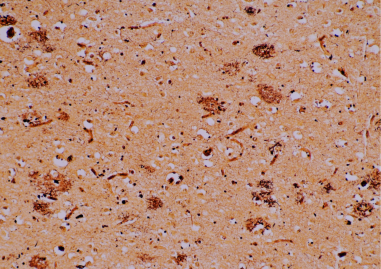Antibodies (Neuroscience)
With advances in the field of neuroscience, the presence of important molecules in neurogenesis and neurological diseases has been revealed. Antibody experiments are essential for elucidating the mechanisms of neurogenesis and neurological diseases based on functional analysis of these important molecules. Fujifilm Wako offers highly efficient antibodies against molecules, such as Iba1, BDNF, and amyloid β (Aβ), which are important for research in the field of neuroscience.
Product Line-up
More Information
Important molecular in each field of neuroscience research are described below.
Glial Cells
Microglia

Microglia, a type of glial cell phagocytose debris and dead neurons from the central nervous system, playing a role similar to that of macrophages in the immune system. Iba1 (Ionized calcium binding adaptor molecule 1) is a protein expressed specifically in microglia in the central nervous system1) and widely used as a microglia marker. Fujifilm Wako's anti-Iba1 antibody (rabbit) is widely favored by researchers all over the world.
Glioma
Glioma is a cancer that arises from glial cells (neuroglia) and is the most frequent (~ 30%) among primary brain tumors2) . In the WHO Classification of Tumours of the Central Nervous System, revised 4th edition, published in May 2016, molecular diagnosis based on the molecular genetic classification of tumor tissues is nearly mandatory for pathologic classification of gliomas. Gliomas are classified based on the presence or absence of mutations in IDH (isocitrate dehydrogenase) 1, IDH2, ATRX, or p53 gene, as well as chromosome 1p/19q codeletion (loss of the short arm of chromosome 1 and the long arm of chromosome 19).Mutation in the promoter region of TERT (telomerase reverse transcriptase) gene is reported as a mutation found in almost all glioma with IDH gene mutation and 1p/19q codeletion.
Neurological and Psychiatric Disorders
Alzheimer's Disease

Dementia is a disorder that leads to cognitive decline, including memory loss, aphasia, apraxia, and executive dysfunction. There are several types of dementia, including Alzheimer's disease, Lewy body dementia, and vascular dementia, while Alzheimer's disease is known to be the most common form. Alzheimer's disease, which was first reported by Alois Alzheimer in 1906, is characterized pathologically by senile plaques (insoluble deposit formed by aggregation and accumulation of amyloid-β) and neurofibrillary tangles in postmortem brains.
Although the molecular mechanism of the onset of Alzheimer's disease has not yet been elucidated, there is a widely-accepted hypothesis in which Amyloid-β (Aβ) gradually accumulates in the brain over several decades before the onset of the disease, tau protein which is a microtubule-associated protein, and especially phosphorylated tau protein, subsequently causes neurofibrillary tangles, and finally neuronopathy occurs and causes symptoms.
Parkinson's Disease
Parkinson's disease is a disorder with symptoms of rest tremor, rigidity, akinesia, and postural reflex disturbance, and autonomic dysfunction and cognitive impairment can be manifested. The disease is characterized by the appearance of structures called Lewy bodies and associated neuronal loss in the substantia nigra and locus ceruleus. Lewy bodies contain phosphorylated α-synuclein protein, and accumulation of α-synuclein has been considered to be implicated in the pathogenesis.
Depression
Depression, also known as major depressive disorder, is a type of mood disorder in which people experience depressed mood for a long period of time. Although there a variety of hypotheses exist regarding the mechanism of onset of depression, the monoamine hypothesis, in which depression is caused by a decrease in the concentration of monoamines (serotonin, noradrenaline, dopamine) in the brain, had been proposed long ago, and inhibitors against the serotonin transporter (SSRIs) have been used as the first choice of therapy.
Previous studies showed that serum concentration of brain-derived neurotrophic factor (BDNF) was significantly lower in depression patients compared with healthy subjects, that severity of depression was correlated with serum BDNF concentration, and that the serum BDNF concentration was increased by use of an antidepressant. BDNF is also expected as a disease marker of depression.
Blood-Brain Barrier (BBB)
The blood-brain barrier (BBB) is a system that regulates the exchange of substances between blood and brain. While it prevents foreign substances from entering the brain, it also prevents drugs from reaching the brain; treatment that allows the drug to pass through the blood-brain barrier is therefore necessary to deliver the drug to the brain. Claudin-5 is an approximately 23 kDa protein four transmembrane domains expressed in the BBB. Neutralizing antibodies against Claudin-5 have been shown to reduce the barrier function in a BBB cell model3).
Neural Markers
Photoreceptor Cells

Light received in the retina is converted into a membrane potential response by photoreceptor cells (rod cells and cone cells), and the electrical signals are transmitted to the brain through bipolar cells, ganglion cells, and optic nerve cells. Proteins involved in the development of the optic nerve or localized at the tip of the optic nerve (villi) are used as marker proteins of photoreceptor cells.
Olfactory Nerves
The olfactory system receives mainly volatile chemical substances and converts their signals into electrical signals for transmission. The olfactory marker protein (OMP), known as a marker protein of the olfactory nerve, is a soluble acidic protein expressed on mature olfactory nerves of vertebrates and is involved in the olfactory signal transduction pathway4).
References
- Ito, D., et al.,: Mol. Brain Res., 57(1), 1(1998).
Microglia-specific localisation of a novel calcium binding protein, Iba1 - National Cancer Center Japan (2 Apr. 2021)
https://www.ncc.go.jp/jp/ri/division/brain_tumor_translational_research/project/020/20170907102931.html (2021) - Hashimoto, Y., et al.: J. Pharmacol. Exp. Ther., 363(2), 275 (2017).
Claudin-5-Binders Enhance Permeation of Solutes across the Blood-Brain Barrier in a Mammalian Model - Koo, J. H., et al.: J. Neurochem., 90, 102 (2004).
The interaction of Bex and OMP reveals a dimer of OMP with a short half-life
For research use or further manufacturing use only. Not for use in diagnostic procedures.
Product content may differ from the actual image due to minor specification changes etc.
If the revision of product standards and packaging standards has been made, there is a case where the actual product specifications and images are different.




